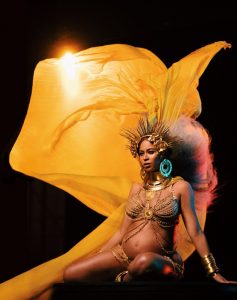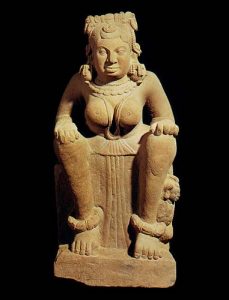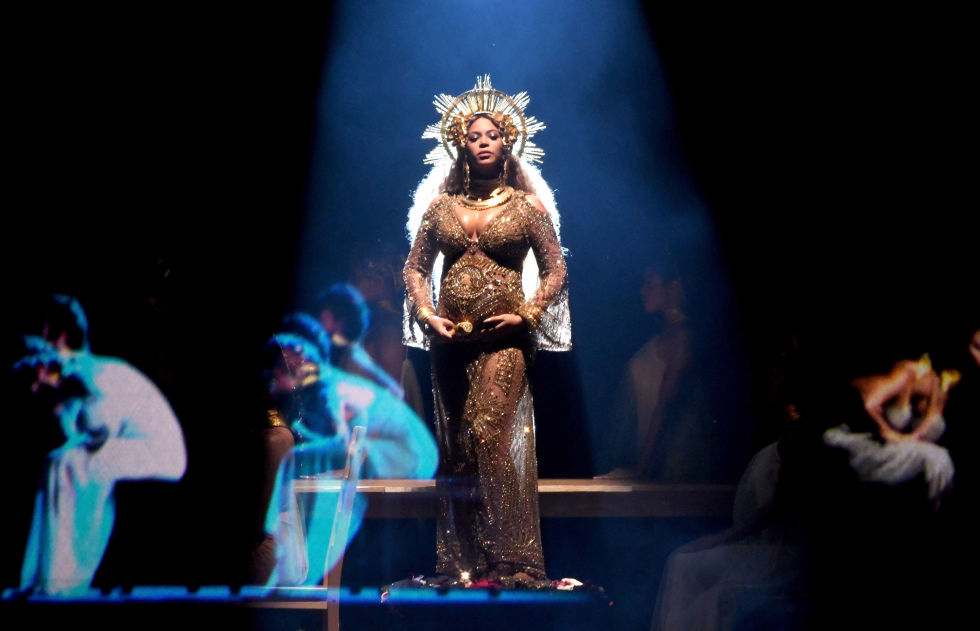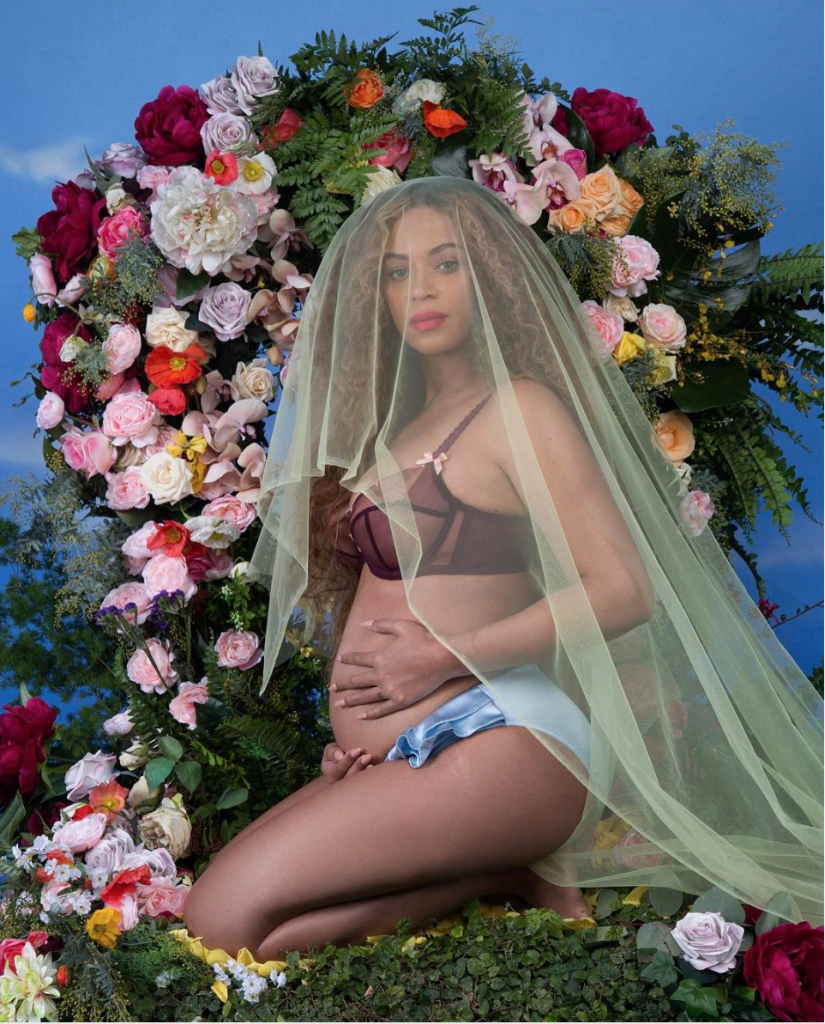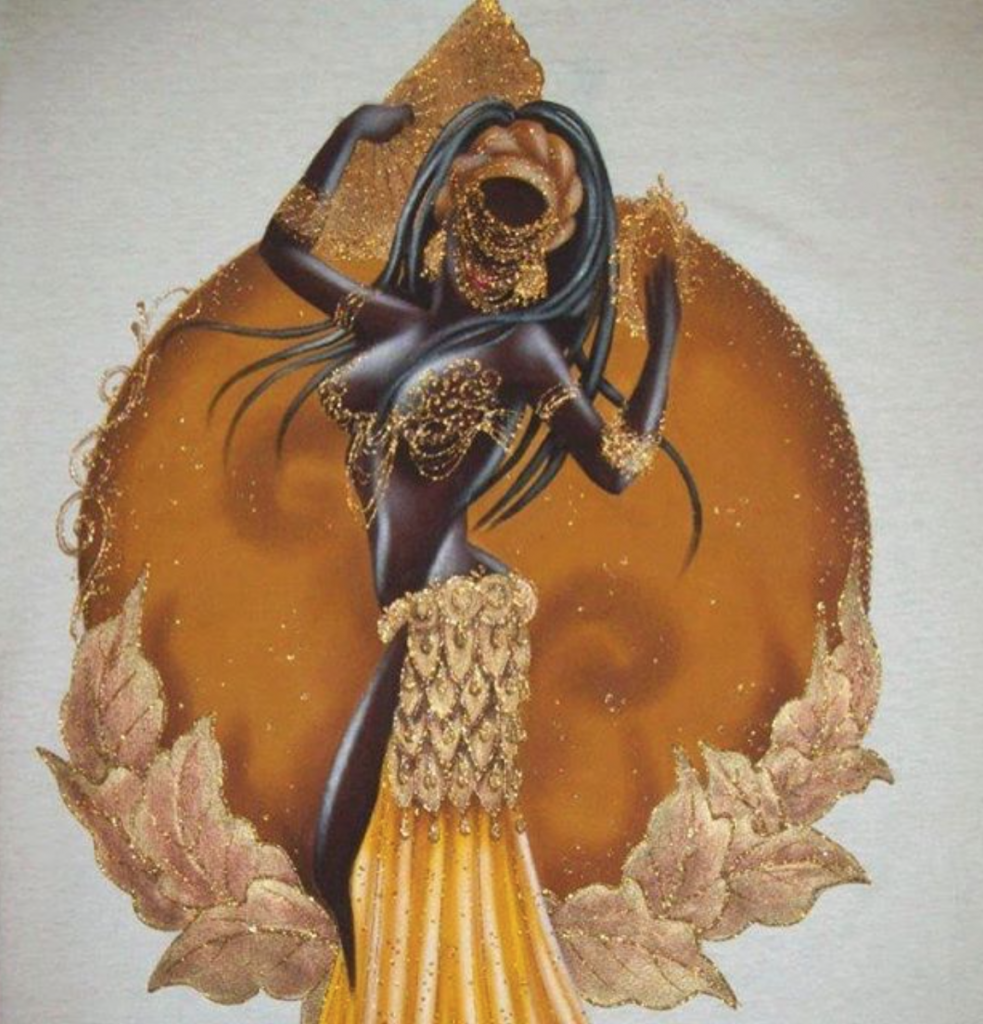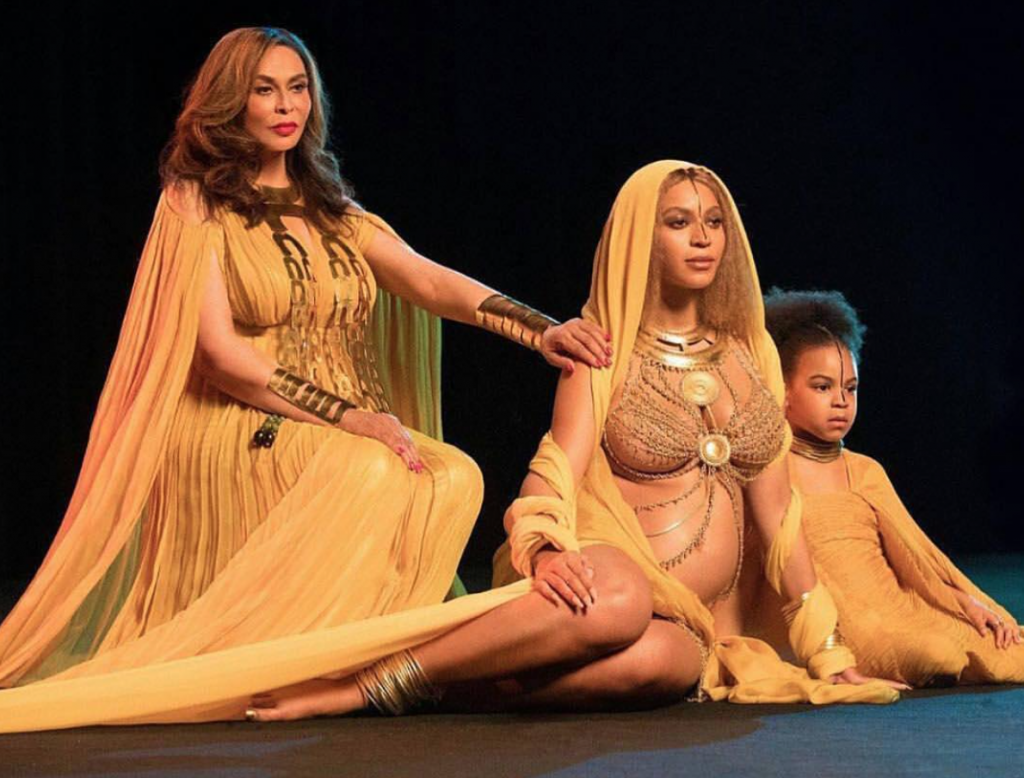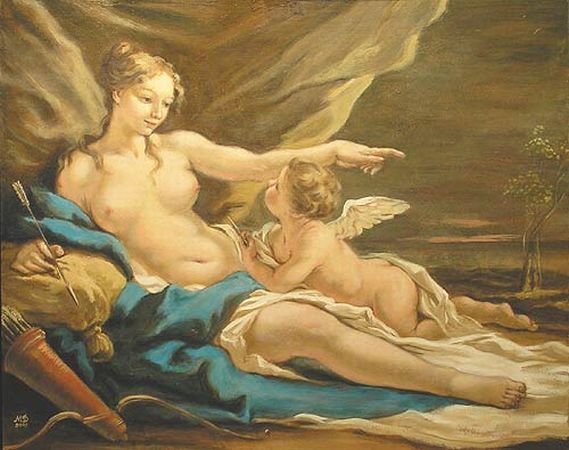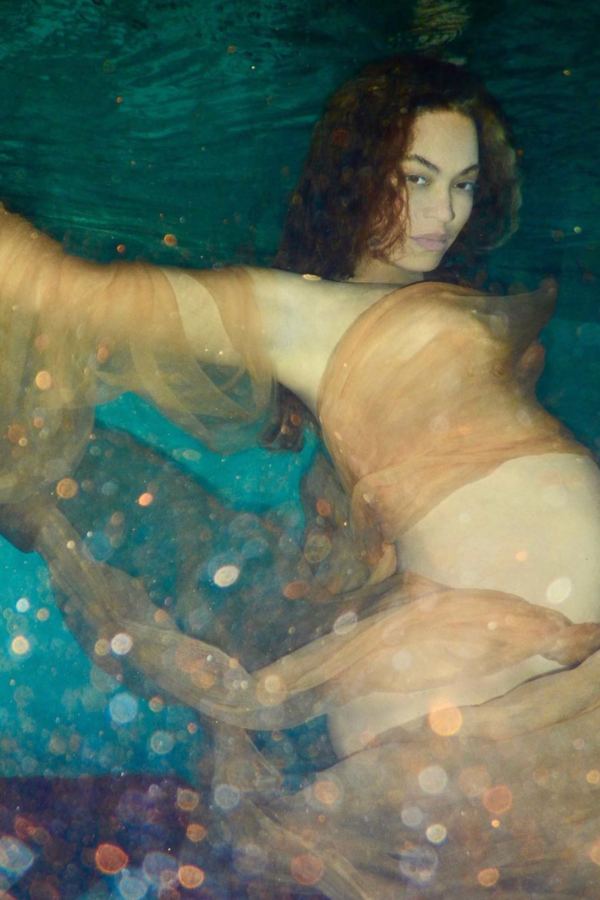In the wee hours of a Sunday night, I found myself engaged in a heady Twitter exchange about whether superstar songstress Beyonce had either evoked the orisha Oshun or the syncretized Virgin Guadalupe of Mexico.
I thought it was clear.
She had evoked both dieties– and more. I saw references to the Roman Venus, the Hindu Kali Ma, and possibly the Egyptian Isis.
Beyonce’s performance of motherhood, beginning with her decadent photo series (worthy of a wall at the MoMA) and culminating in her ten minute medly at the Grammy awards, had not been about honoring one particular diety– but rather using her global platform (and twin fetuses) to challenge modern notions of femininity and motherhood by conjuring the image of powerful creation deities that predate judeo-Christian culture.
Every goddess she called forth represented a unique message to womankind–it’s one of those many instances in which her visual artistry is more significant than her actual song.
For some 25,000 years mankind honored women as the creators of life, primary providers of food, builders, artist ands, healers, priestesses and leaders. Across cultures, motherhood, above all, was perceived as nothing short of supernatural.
Feminine creativity, the power to manifest physical and psychic reality, is one of the Goddess’ primary aspects. People identified ‘the feminine’ as the source of all being–and as such, men and women in the early gynocentric societies tended to live in partnership, rather than domination.
Today, when we evoke cross-cultural images of the the Great Mother, as Beyonce has, it is not a cue to retreat to old ways, some romanticized, pastoral version of herstory.
The evocation of the divine feminine is a call for women to acknowledge their own sacred energy as a legitimate source of independent power. Reawakening the Cosmic Creatress on a global stage asks that we, as women, use our innate powers to take control of our destinies.
I invite you to explore her use of spiritual imagery as we unravel the her hidden messages to woman kind.
[divider]
Beyonce as The Virgin of Guadalupe
With the elaborate use of lighting optics and holograms, Beyonce, dressed as La Virgen in her signature gold spiked crown and mantle, appears and reappears on stage– a nod to the three apparitions of The Virgin Mary before Juan Diego, an essential aspect of La Virgen de Guadalupe’s legend.
La Virgen de Guadalupe is simultaneously a figure of religious reverence and cultural rebellion.
In 16th century Mexico, a poor Aztec Indian named Juan Diego was said to be walking through the Tepayac hill country in central Mexico when he encountered a beautiful woman surrounded by a ball of light. Speaking in his native tongue, she identified herself as the Virgin Mary and asked that a church be built on the site. She appeared before him three times, asking that a chapel be built in her honor at that site.
Juan protested that no one would believe he’d seen her, so she pointed and suddenly among the cactus grew roses– the flower of the heart and of her love for humanity. Juan gathered the roses in his cloak and headed straight to the bishop. As he unrolled his garment, an image of the Virgin as a pregnant, dark skinned Indian woman appeared with stars on her cloak, a crown on her head, and rays of sun surrounding her.
Today Catholic scholars have openly doubted the historical existence of Juan Diego, but this we do know– following the Hernan Cortes’ conquest in 1521, a Mexican temple honoring the Aztec creation goddess Tonantzin was dismantled and replaced with a chapel honoring the Virgin Mary. In Mexico, this apparition was named La Virgen Maria de Guadalupe–and from the beginning she was a connection between their polytheistic, goddess past and their Christian future.
The Aztecs … had an elaborate, coherent symbolic system for making sense of their lives. When this was destroyed by the Spaniards, something new was needed to fill the void and make sense of New Spain … the image of Guadalupe served that purpose. -Patricia Harrington
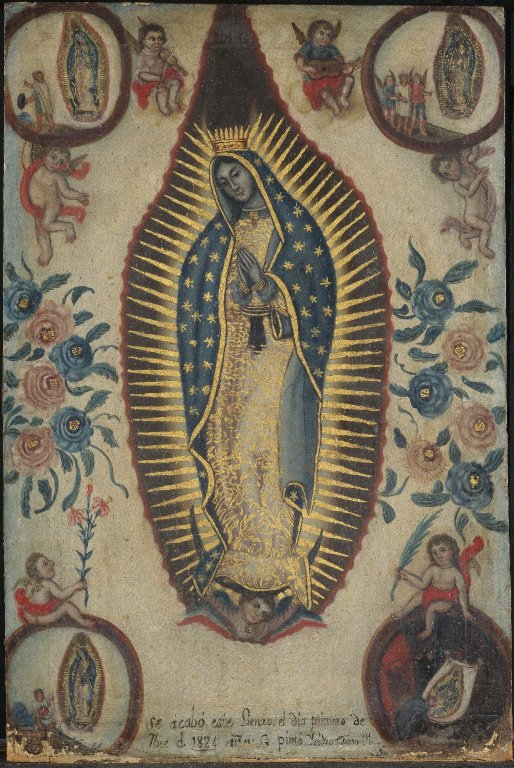
Many Aztecs continued their worship of creation goddess Tonantzin through La Virgen. Her belt is said to represent her pregnant state. Even her artistic rendering, always cast in the shape of a yoni, surrounded by roses and baby angels, suggests her fertility goddess origins.
Infused with a note of kisch (maybe even a nod to Kehinde Wiley) Beyonce references the La Virgen by draping herself in a blue-green mantle, and surrounding herself with roses, Guadalupe’s sacred flower– said to represent maternal love and fertility.
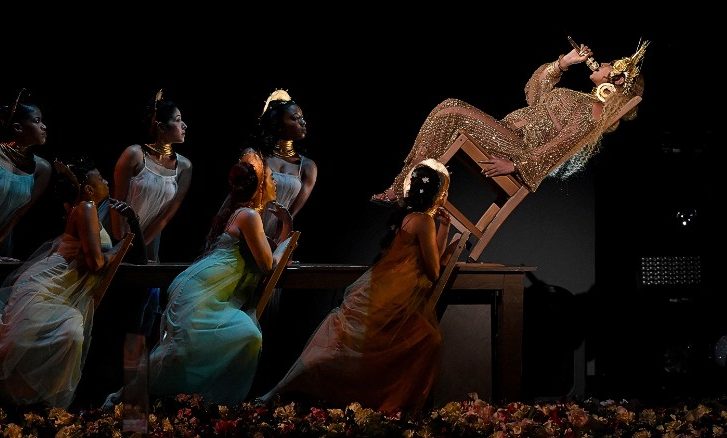
Surrounded by women who represent the cherub angels on one of the iconic renderings of La Virgen, they wear blue-green dresses, the color of her mantle, and dance atop a bed of roses, her sacred flower. They also, for a moment during Beyonce’s Grammy performance, evoke a powerful reference to The Last Supper.
La Virgen embodies unconditional motherly love, but more than anything she embodied refuge from colonial conquest– a means of honoring their original creation goddess under the guise of Christianity. Newly converted natives continued to come from afar to worship there, often addressing the Virgin Mary as Tonantzin.
Her blue-green mantle was the color reserved for the divine couple Ometecuhtli and Omecihuatl that represented the dual cosmic energies, and her belt is interpreted as a sign of pregnancy. La Virgen was called “mother of maguey (the aloe plant) and the source of the sacred beverage polque, also known as “the milk of the Virgin”. Even the rays of light that surround her image are said to represent the spines on the maguey plant.
This is why Beyonce’s choice to represent her is fascinating. The singer is deliberately blurs the line between the Christianity and gynocentric spirituality. As such, she reminds that our goddess past is ever present, still influencing the way we worship and connect today. She directs our attention to a time prior to the ascent of patriarchal judeo-christian religion, when the divine feminine served as a projection of our power as women to create, transform and manifest physical and psychic reality.
The Message: Patriarchal society elevates the concept of feminine chastity as a means of punishing women for their sensuality and encouraging them to suppress this creative, magnetic, life-affirming power. This wide-spread suppression of our erotic instincts is not only confusing to women, but detrimental to our relationships, our spiritual and mental well-being. Our ability to manifest anything we want is nothing short of miraculous. Honor it.
[divider]
Beyonce as Oshun
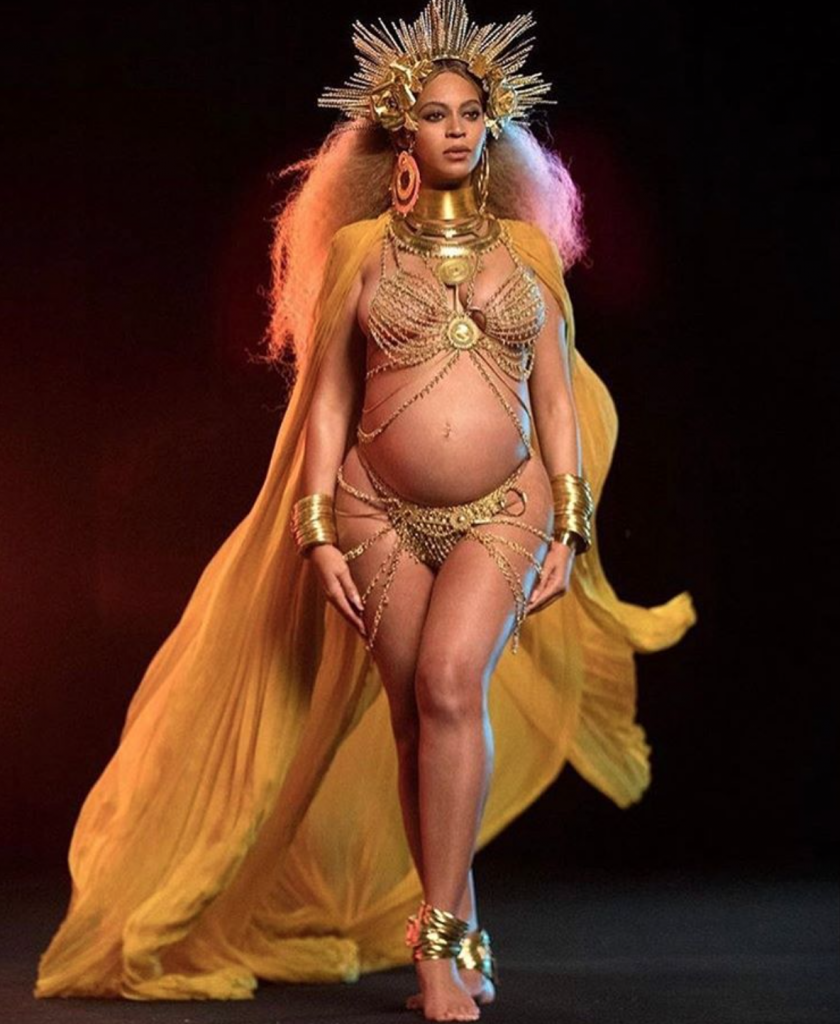
Beyonce evokes the Yoruban goddess Oshun by wearing her signature color yellow and gold jewelry. The deity reins over the sweet (fresh) waters, hence the billowing effect of her cape.Beyonce’s african jewelry serves to further emphasize her reference to African spirituality.
An archetypal symbol for the feminine principle, Oshun reins over the sweet waters (fresh water) and the realms of sensuality, creativity and abundance. In Beyonce’s recent body of work, Oshun is a well-known artistic reference to West African matriarchal iconography.
Ochun represents the creative and procreative force that exists in all women, the passionate, erotic energy that can be channeled into the creation of new art, new life, or even a new reality. This life force has many names in eastern philosophy, from shakti to kundalini, but most notably, it is the one powerful aspect of femininity that patriarchy attempts to suppress, opting instead to subject women to the contrived virgin/whore binary, both of which deprive women of their instinctive powers.
Sensuality, creativity and abundance are the gifts of Oshun.
Standing on the stage adorned as Oshun, in gold jewelry that adorns her enchanting, pregnant body– Beyonce represents two realms of womanhood that are traditionally kept apart– woman as mother, and woman as lover. All too often our society attempts to reduce womankind, in all of our manifestation power, to vessels of life and pleasure. In a sense, we are laborers– our bodies designated to deliver life and to deliver pleasure– in both instances, our bodies are at work for others.
The fascinating aspect of Oshun, and all of the creation/love deities like her, is that she embraces pleasure for the sake of pleasure. When we engage in ‘self-care’ we activate our own inner Oshun. She walks around with a honey pot tied around her waist, this nectar symbolic of both sexual release, and her own inner contentment.
In this image, Beyonce evokes the orisha along with her mother and daughter. She is simultaneously referencing the powerful mother/maiden/crohn trinity that predates modern religion.
In myth, Oshun seduces out of fullness. She transforms the lives of those around her by ‘sharing’ the sensual, abundant energy she carries within. Hence her gifts to civilization, are music, dance, art, poetry, and the passion that ultimately spawns new life.
When we talk about empowering women, so often we do so in within the context of denying our sensuality– not wanting to be seen as vessels of erotic energy. Sensuality carries a distincitly negative connotation in patriarchal society–there are women who can not imagine connecting to their body if it isn’t in the context of making babies or pleasing a man. What else can we expect in a culture that exalts above all else, a virgin birth?
A critical aspect of our empowerment is acknowledging and owning this creative life force; the Oshun, within us. We all have access to this mysterious and magnetic energy; some of us are overwhelmed by it, and others suppress it, but we all have access to this creative energy that mankind has exalted for years—and we can use it to heal, transform, and take charge of our personal and sexual destinies.
The Message: In order to give pleasure, one must know pleasure. Keep your ‘honey-pots’ full. Your pleasure is a privilege for yourself and a gift to others.
[divider]
Beyonce As Venus
Having emerged from the sea a fully developed woman, Venus, like her Greek counterpart Aphrodite, is the goddess of passion, eroticism, and creative force. She is goddess of the waters, the source of life and the element linked with emotions. Like women, water has the capacity slake, transform and destroy. She represents the transformative power of love and sexuality, and our capacity to grow through joy and pleasure.
Often portrayed in the nude, bathing or wringing her hair after emerging from the sea, her exposure lacks of self-consciousnessness– much like Beyonce, who stood before the world, ripe in her womanhood, and exuded total and utter confidence in her body. When we as women connect to the Venus in us, we experience a lightness of being. When we are passionately involved with a project or a partner, Venus moves through us.
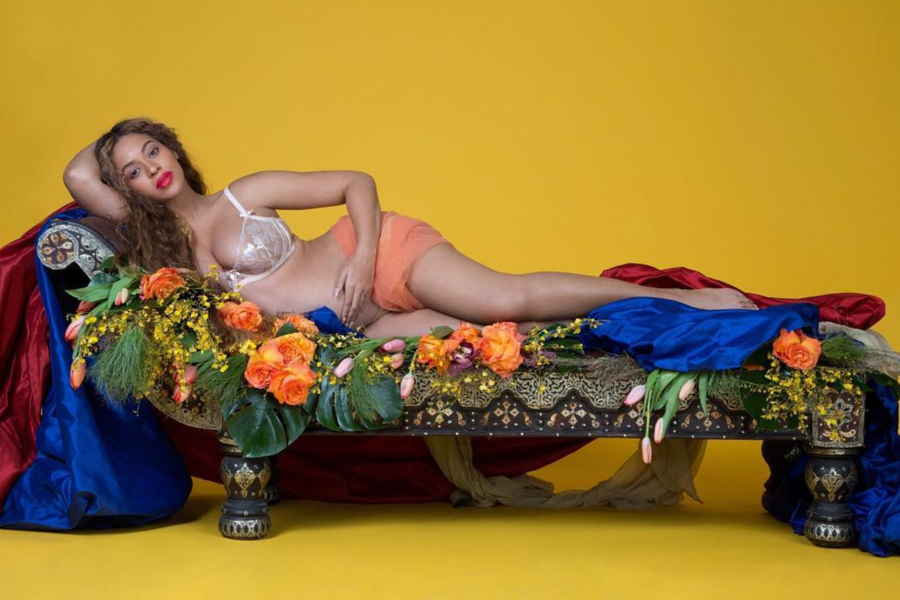 In this image of a reclining Beyonce, she still incorporates Mexican influences, and the gold of Oshun, but also poses like the Renaissance depictions of the Roman goddess Venus.
In this image of a reclining Beyonce, she still incorporates Mexican influences, and the gold of Oshun, but also poses like the Renaissance depictions of the Roman goddess Venus.
A depiction of Aphrodite (the Greek equivalent of Venus) with her son Eros. Aphrodite/ Venus is often portrayed reclining.
Venus is said to have risen from the sea, fully formed. Water is a powerful metaphor for feminine power– representing our capacity to slake and destroy.
Roman theology casts Venus as the yielding, fluid female principle, not unlike the chinese concept of tao, which is essential to the balance of dual cosmic energies. She tempers the masculine and can bestow abundant gifts of military victory, sexual success, good fortune and prosperity.
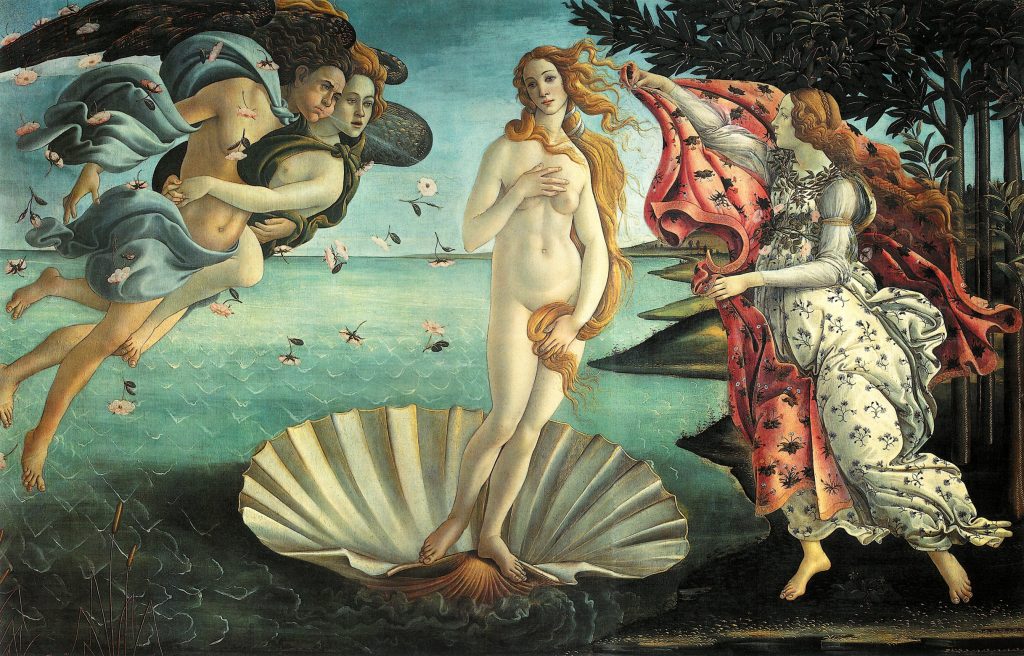 Sandro Botticelli’s famous ‘Birth of Venus’.
Sandro Botticelli’s famous ‘Birth of Venus’.
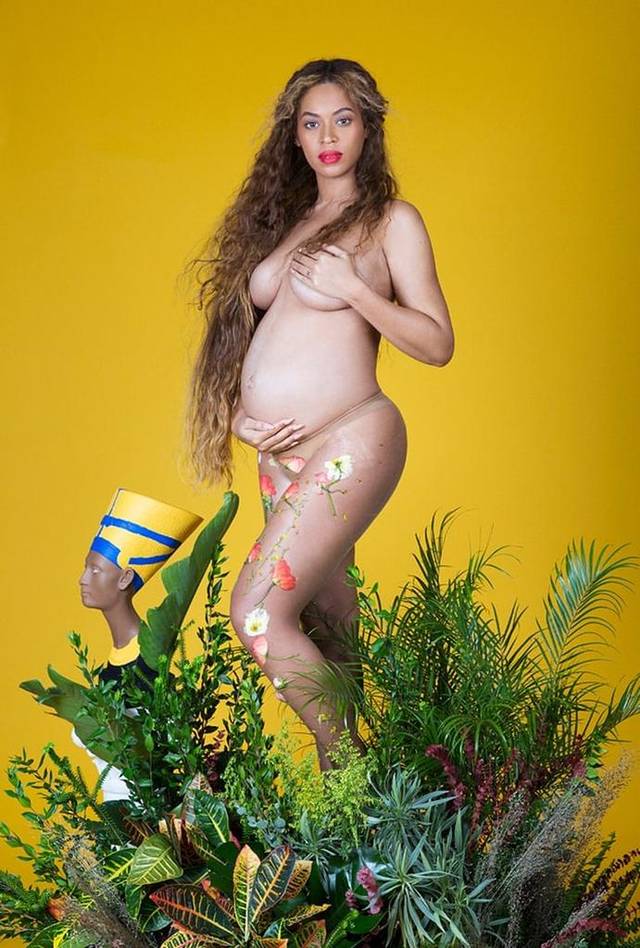 Beyonce, recreating the classic Birth of Venus while incorporating Egyptian imagery and Oshun’s golden yellow.
Beyonce, recreating the classic Birth of Venus while incorporating Egyptian imagery and Oshun’s golden yellow.
The message: Our society leads women to live in their heads, but sensuality happens when we connect to our bodies whether it be through dance, massage, or even sex– and we own every inch of our splendor. Contemporary images of beauty are designed to induce ‘longing’– beauty as we know it is a product of commercial culture. Real beauty happens when we ‘altar’ ourselves–even if not on the world stage–at least in front of the bathroom mirror. In an eros-phobic culture, self-admiration is considered vanity, but in actuality it is one of the gateways to feminine power.
[divider]
Goddess Tripping Into the Future
When we reclaim the divine feminine, we acknowledge our goddess past. This is not an act of worshipping or even longing for an entity without, rather, it is about acknowledging something sacred within. As we goddess-trip deeper into the 21st century,with all the unique challenges and opportunities it will present woman kind, we must recognize that the sheroic qualities humans worshipped for the better part of history are not fantasy– they are in us. We are vessels of deep love, pleasure, creativity, knowing, and miraculous healing energy. We have the capacity to heal ourselves, to heal our world, to transform any condition, and to create any reality. We. Are. Magic.
Powerfully yours,
Ayesha
PS: The shadows of these great goddesses continue to exert their pull on womankind today through the force of psychological archetypes. Discover the 7 feminine archetypes that underscore your life story, or take a free quiz to uncover the captivation ‘goddesses’ within you.
The founder of Women Love Power®, Ayesha K. Faines is a writer, media personality, and brave new voice for feminine power and social change. Sought after for her provocative insights on culture, mythology and gender politics, she has been featured on MTV, Essence, Entertainment Tonight, The Michael Baisden Radio Show, AfroPunk, and Time among other media outlets. She’s traveled the world lecturing before a number of universities, and she pens a column for Zora Magazine that explores the intersection of love and power. She is best known as a featured panelist on “The Grapevine”. Ayesha is a graduate of Yale University and a former television journalist.
